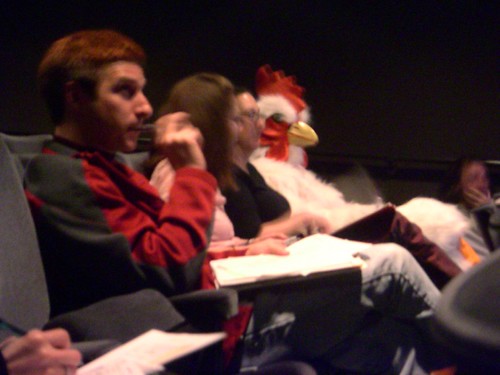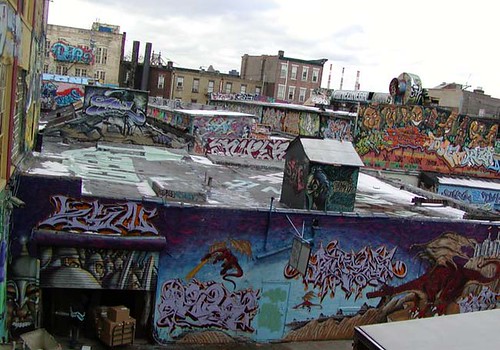All posts by Cassidy Curtis
Robots!
Blue Sky‘s new movie Robots is quite an artistic accomplishment. Sure, the plot’s a bit predictable and some of the jokes fall flat. But in terms of animation, this movie is stunningly, wonderfully original. My hat is off to directors Chris Wedge and Carlos Saldanha: they have raised the bar with this picture, and we should all take note! These guys set a really tough challenge for themselves, and they consistently lived up to it.
What was the challenge? How to take a ridiculous design like this:

and animate it in a way that’s both believable and appealing. Let’s analyze for a moment just how hard this is. These characters are made of rigid metal parts, so you can’t let the audience see them bending and squishing around, or they’ll start to look like rubber. And yet, if you limit yourself to rigid transformations, you won’t be able to hit those really strong expressive poses that make the character come alive.
What was Blue Sky’s solution to all this? Extremely snappy animation. Hit a pose, stick it, hit another pose, follow through, and so on. If your transitions are fast enough, you can get away with all kinds of non-rigid contortions, as long as you stick to rigid joint movements once you hit that pose. Of course, I’ve only seen the movie once, so I may be misreading it, but I suspect that that was how they made this work so well. Stage magic, folks!
Blue Sky is like the dolphin cousin of the rest of us primates in the animation world. They branched off from our common ancestors lo some twenty years ago (an eternity in CG years), and started doing things their own way. Now they’ve evolved into something sleek and elegant. They make this monkey want to go surfing.
The Graffiti District
If I were mayor, there would be a whole neigbhorhood devoted to street art. The Graffiti District. Every wall in the district would be legal to paint on. If you owned property in the district, you would be required to provide your exterior walls as a canvas for artists.
coincidence and holographic memory
In a recent Flickr discussion, I started to articulate some ideas about how networks like Flickr increase the frequency of coincidences in our lives. Dose blogged the thread, and started a nice little discussion just about that topic. And I think Eric is onto the same concept here.
What happens when we start to archive everything around us, and upload it to a network in which things get tagged and linked together on the basis of real or perceived meaning? Coincidences happen.
Why I like Flickr
About a month ago, I got hooked on Flickr. My friend danah has insisted that I write something about it.
The back story: since 1999, I’ve been working on a project called Graffiti Archaeology. I shoot photos of graffiti-covered walls over a span of years, and document how they change over time.
I can’t be everywhere at once, though, so I must also rely on other people’s photos to fill in the gaps in my historical record. By the time when I launched the website in November 2003, I had received permission to use the photos of perhaps a half-dozen other photographers, most of whom I had contacted individually via their own graffiti-themed websites.
One of my goals has been to expand grafarc beyond San Francisco, to cities I’ve never been to. But this means relying entirely on other people’s photos. This research task (finding the photos, tracking down the people who took them, and sleuthing out exactly where and when they were taken) is almost as labor-intensive as producing the website itself.
That is to say, it was labor-intensive, until I joined Flickr. On my first day on Flickr, I found the Graffiti group, containing hundreds of photos uploaded by people all over the world. I also searched for tags like graffiti and its variants (grafitti, graf, etc.). I refined my search with location tags like San Francisco or Los Angeles. I immediately found dozens of photos I wanted to use on my site.
Flickr’s use of tags and EXIF data took all the effort out of finding the wheres and whens. Contacting the people who took those photos was effortless, because of Flickr’s people-centered paradigm. What’s more, Flickr is a self-selecting community of people who are predisposed to share. So when I asked people to let me use their photos on grafarc, they did so freely and enthusiastically.
What happened next took me by surprise. Coincidences began to materialize out of the ether. I met a new contact from LA who had recently shot some graffiti in Zagreb, and he offered to go back and shoot the same spots on his next trip. Another contact, from Peru, began uploading photos of spots I’d been to in Belo Horizonte, Brazil. And both of these people had independently shot photos of the same subway station in Budapest, four years apart. Meanwhile, here in San Francisco, my local contacts triangulated their cameras on emerging hotspots, and began recording their progression at near-filmic frame rates. And one person contacted me who had been in the same abandoned building as me, at exactly the same time. Something about the structure of Flickr seems to make this kind of coincidence commonplace.
I created a Flickr Group for contributors to grafarc, and invited about a dozen friends and contacts. The group has begun to grow at a steady pace, and its photo pool has filled up with rich, loamy data. I am now swimming in photos. And people who have met up there are now sharing information via comments on each other’s photos, creating a rich discussion space around them.
The funny thing is, this is something I always envisioned for grafarc. I wanted the site to attract the people who share my weird obsession with graffiti, and I wanted it to become a center for this kind of discussion. I imagined that at some future time, I would add a forum section to my site, and somehow create that community. But the community apparently couldn’t wait for me to do that. In Flickr’s fertile and promiscuous environment, communities can form spontaneously around the tiniest kernel.
I can’t wait to see what will happen next.


